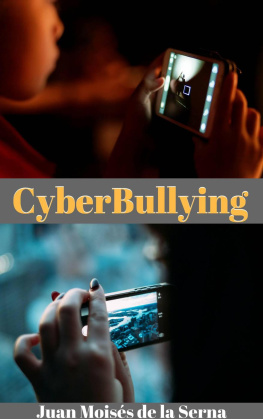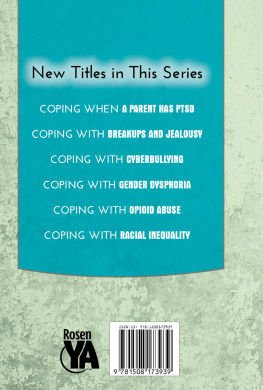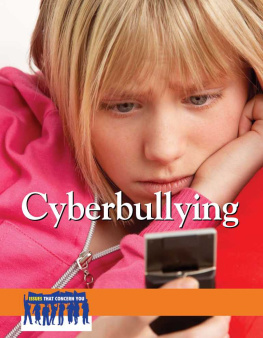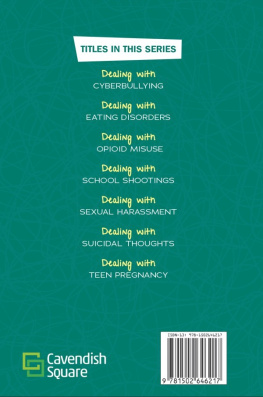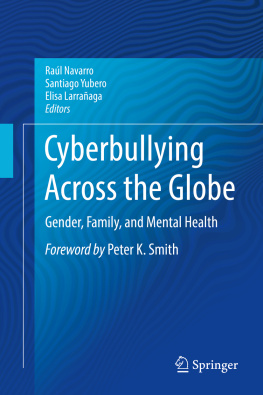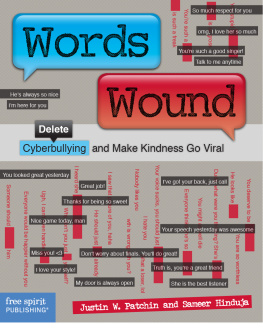Cyberbullying
Juan Moises de la Serna
Translated by Conchi Fuentes
Cyberbullying
Written By Juan Moises de la Serna
Copyright 2019 Juan Moises de la Serna
All rights reserved
Distributed by Babelcube, Inc.
www.babelcube.com
Translated by Conchi Fuentes
Babelcube Books and Babelcube are trademarks of Babelcube Inc.
Cyberbullying
By
Juan Moiss de la Serna
Translated by Conchi fuentes
Table of Contents
Dedicated to my parents
Acknowledgements
I would like to take this opportunity to thank all the people who have collaborated with their contributions in the production of this text, especially Dr. Abel Gonzlez Garca, Director of the Department of Criminology, Distance University of Madrid and D Pilar Vecina, Director of the Department of Neuropsychology at the Institute of Research and Social Development of Uncommon Diseases.
Chapter 1. Introduction to Cyberbullying
S urely you will have heard in the press how more and more young people are becoming involved in cases of harassment via digital media, mainly because of its extensive usage, but also due to the anonymity provided by the network.
Cyberbullying involves the humiliation, blackmail and even harassment of one or more people over another. This can come from being "different" in some way, taller, fatter, supporting a certain soccer team...
If we look at the results offered by Google, on search tendencies for the term cyberbullying, and its different meanings around the world from 2004 to 2017, it can be verified that the country most concerned about it, is the Philippines, followed by Australia and New Zealand; with the United States in seventh position, and Spain occupying position number thirty-six of the forty-five countries that make up the results, and with Turkey occupying the last position.
This does not reflect the number of cyberbullying cases in the country, but the times that this term has been searched, tit may be that a country has few cases of cyberbullying and yet the population may be very sensitive about it, therefore Google will show a high number of related searches.
On the contrary, a population where cyberbullying is institutionalized may have a low awareness of the problem, resulting in very few searches.
It should be noted that among the top ten countries searching for this term, five come from the countries of the so-called first world, such as Australia, New Zealand, United Kingdom, United States and Canada.
In addition, over the years there has been a significant global increase in the use of this term. In 2017, there were over 65% more searches carried out than in 2004.
If a cumulative analysis of seasonal search trends in Google is performed, one can see how it is in the fall months of September and October when more searches related to the subject of cyberbullying are made; while in the summer months of July and August; and in winter, December and January, fewer searches are carried out.
Cyber abuse with sexual content also occurs, but it is not exclusive; in many cases, sexual content is used for the same purpose of humiliation or blackmail, without being the ultimate objective of the abuser.
What is cyberbullying?
Cyberbullying is a type of abuse and harassment among school children that is characterized by the use of communication via cyberspace to achieve the total exclusion of the victim from their school groups. >>
Dr. Abel Gonzlez Garca, Director of the Department of Criminology, U.DI.MA. (Distance University of Madrid)
It is expected that as technology becomes more popular, so will the advantages and disadvantages of its use and abuse, including cyberbullying; although there is still much to be investigated about this, due to the fact that the victim is often blackmailed by the abuser into not reporting the bullying.
Despite this uncertainty, some governments have taken measures to prevent its most damaging effects on children's health, which has sometimes led to the child taking his own life, due to the desperation of not knowing how to get out of the situation.
Has there been more cyberbullying in recent years?
Indeed in recent years there has been more cyberbullying because of the intensified use of Internet communication tools, especially social networks (Twitter, Facebook, Ask.fm, WhatsApp, etc.).
Currently almost 100% of schoolchildren over 10 or 11 years old regularly use some kind of technological tool.
It is also logical that the aggression is moving towards this new area of relations because it has become easier to carry out the aggressions.
Dr. Abel Gonzlez Garca, Director of the Department of Criminology, UDIMA
This is a current problem that is barely reported in the media. This only occurs when the police catch a cyberbully or one of their victims commits suicide; only then is a certain visibility given to a problem that has been on the increase in recent years.
It seems to be that neither parents nor teachers are sufficiently prepared to detect the first symptoms in the victim, and they do not know how to react adequately to end the problem.
For this reason, various governments have implemented cyber abuse prevention policies to protect the child and to try and stop a phenomenon that seems to have become a trend, cyberbullying.
Chapter 2. What is cyberbullying?
T he term cyberbullying is an extension of technological media harassment, by telephone or online, whereby one person (the cyberbully) tries to undermine the self-esteem of another (the victim) by sending threatening, intimidating or blackmailing messages via e-mail or instant messaging services (chat or messenger), SMS or social networks.
Before the extensive use of technology, the bullying or harassment phenomenon was a face-to-face encounter between the cyberbully and the victim, accompanied by insults, threats and humiliation, which could also lead to physical aggression by the cyberbully in order to achieve his or her objective.
Some experts differentiate cyber abuse and cyberbullying, the former being produced through the use of new technology; restricting the term of cyberbullying only to cases in which the harassment is carried out among minors using technological media.
In Spain, for example, the growing number of cases among adolescents, is especially worrying, with almost a third of children under the age of 17 admitting to having suffered cyberbullying, and 19% even admitting to having insulted others on the Internet. In Latin America, according to UNESCO data, more than 50% of primary school students have been victims of bullying, a danger that is magnified on the Internet.
Next page
